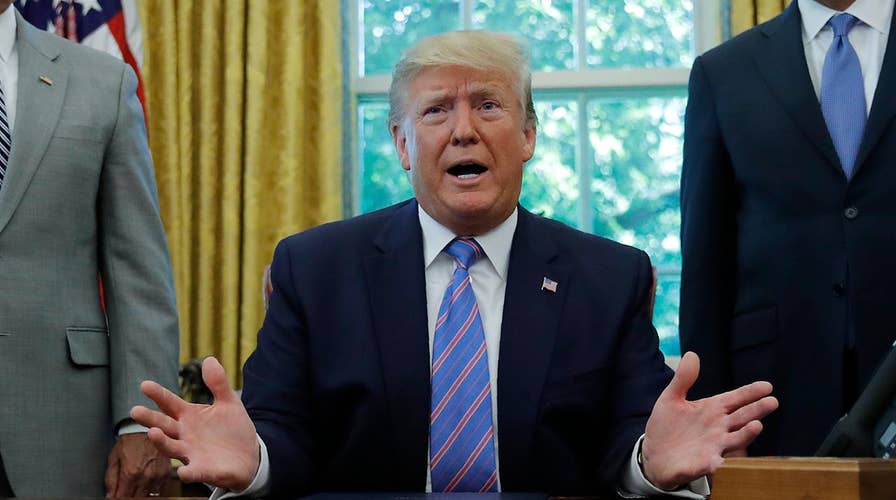Trump says Democrats want to treat illegal immigrants better than American citizens
Press pushes 2020 Democrats on open borders agenda; panel reaction and analysis on 'Hannity.'
The central issue is immigration.
Period.
Federal immigration policy is key to the current struggle at the border. What is secure. What’s not. Who the U.S. should admit. Who it shouldn’t. Major questions loom as to what’s going on in Central America. Many lawmakers are questioning what “draws” migrants to cross into the U.S. illegally – prompting debates over detention conditions, health and the care of children.
That’s to say nothing about the expense.
Immigration – and particularly perceptions about illegal immigration – is what sparked the recent Supreme Court fight about a prospective citizenship question on next year’s census forms. That’s to say nothing of the ex post facto fight where the president said he’d continue to push for inclusion of the citizenship question in the census – despite the Supreme Court ruling. The administration told a federal judge Friday it was still exploring multiple options to include the question.
DOZENS OF CENTRAL AMERICANS RETURNED FROM US ARE SENT HOME BY MEXICO
President Trump’s decision sent government lawmakers and the federal judiciary reeling. This came after Commerce Secretary Wilbur Ross even declared that the Census Bureau would comply with the Supreme Court’s ruling and not ask about a person’s citizenship. Ross ordered the forms printed without the citizenship question. Naturally, that drew the ire of Trump.
Don’t forget that the House Oversight Committee voted in June to approve contempt of Congress citations for Ross and Attorney General William Barr for failing to provide information and documents explaining the rationale for the citizenship question.
The census issue is bubbling into one of the most heated on Capitol Hill.
It’s unclear how things may go with impeachment efforts in the House regarding Russia, election influence and the report by former Special Counsel Robert Mueller. But some Democrats whisper that defiance of the Supreme Court over the citizenship question could present an even more muscular case for Democrats to confront the president. That could only further fuel conversations about impeachment.
The imbroglio over a border wall is what touched off the longest government shutdown in U.S. history last winter. A reprise of that battle could be in store this fall as lawmakers try to forge an accord to fund the government. This autumn’s debate over border security will undoubtedly intensify. That’s because the migration and child detention issue exploded this summer.
HOUSE LAWMAKERS TRADE ACCUSATIONS AMID SCRAMBLE TO PASS $4.5B BORDER BILL: 'PLAYING GAMES'
Many liberal House Democrats are now scornful of officials and agents with Immigration and Customs Enforcement (ICE) and Customs and Border Patrol (CBP). Some Democrats are reluctant to provide any more funding for these agencies in light of what they discovered at detention facilities over the congressional recess. Those views will only sharpen as Congress and the administration creep closer to an October 1 funding deadline for the government. Money for the Department of Homeland Security (ICE and CPB are under the DHS umbrella) will emerge as the flashpoint this fall.
President Trump threatened aggressive ICE raids last month but then pulled back on that decision after a phone call with House Speaker Nancy Pelosi, D-Calif. Trump then granted Congress two weeks to solve the issue. Congress was really only in session for four days of that window. So nothing was solved. It’s unclear if the president will again call for the raids.
Sen. Lindsey Graham, R-S.C., sought an audience in late June with Pelosi to discuss the “pull” factors which draw people to risk life and limb to cross the southern border. Graham asserts that if the U.S. doesn’t take action to curb the magnet effect, the U.S. will be spending “another $4 billion every six months.”
Congress just approved a $4.6 billion spending measure to address humanitarian issues at the border. That’s the money Graham is referring to. However, that legislation wasn’t intended to address what entices people to flee from Honduras, Guatemala and elsewhere, destined for the U.S. border. That’s why Graham envisions legislation which cuts off the problem at the root: by possibly providing assistance for Central American countries to combat the problems which spur the migration.
No bill yet exists. No one is exactly sure what the legislation would look like and what it would cost. Could it get bipartisan buy-in? Would conservative Republicans balk because it’s doling out “foreign aid?” It’s unclear, but it’s significant that a Senate power player like Graham goes across the Capitol to meet with the House Speaker about such a critical issue.
This is why all of these issues boomerang back to immigration. You thought addressing health care was toxic? Try immigration.
Congress last took a serious stab at immigration reform in 2013. A Senate “Gang of 8,” led by now Senate Minority Leader Chuck Schumer, D-N.Y., and, featuring the likes of Graham, the late Sen. John McCain, R-Ariz., and Sen. Marco Rubio, R-Fla., crafted the Border Security, Economic Opportunity and Immigration Modernization Act of 2013.
The package offered a path to citizenship for many undocumented persons already in the U.S. – provided they weren’t criminal or security risks. The bill modernized the nation’s visa system and eliminated the Diversity Visa Lottery. The Congressional Budget Office (CBO) estimated the measure would save the U.S. $700 billion.
REP. BIGGS SAYS BORDER PATROL MORALE TAKING HIT AS CONGRESS CONTINUALLY 'CASTIGATES' AGENTS
The Senate approved the bill 68-32. All 54 senators who caucused with Democrats at the time voted yea. Fourteen Republicans voted aye.
But the bill died in the House.
The Republican-controlled GOP House could never come to terms with the legislation. Ironically, then-House Speaker John Boehner, R-Ohio, could have brought the plan to floor and passed it with a coalition of almost all Democrats and lots of Republicans. But House Speakers loathe handing over authority to the other side. And frankly, had Boehner pulled such a maneuver, his Speakership likely would have ended in 2013 rather than 2015.
The failure of Congress to advance an immigration measure is why President Obama signed a 2014 executive order which allowed for “deferred action” for many illegal immigrants to remain in the U.S. That order became known as “DACA.”
Congress has been paralyzed when it comes to taking any action on immigration. The Republican-controlled House couldn’t even advance two measures last year because the bills offered paths to legal status for some undocumented persons. The Democratically controlled House moved a bill related to DACA a few weeks ago. But Senate Majority Leader Mitch McConnell, R-Ky., has no plans to consider that bill in the Senate.
And so the immigration issue marinates. It manifests itself in multiple forms: The surge at the border and how the government handles those in its custody. The immigration problem presents itself as a potential question in the census – seemingly resolved two weeks ago by the Supreme Court. But, when it comes to the Trump Administration, it’s not really resolved. Then there’s the touchstone of President Trump’s presidential promises: a border wall. And in the back, the threat of ICE raids lurks.
Four distinct policy areas. But not really. They’re all bound together by one underlying theme: immigration. And few on Capitol Hill or multiple administrations have shown the wherewithal to solve it.























